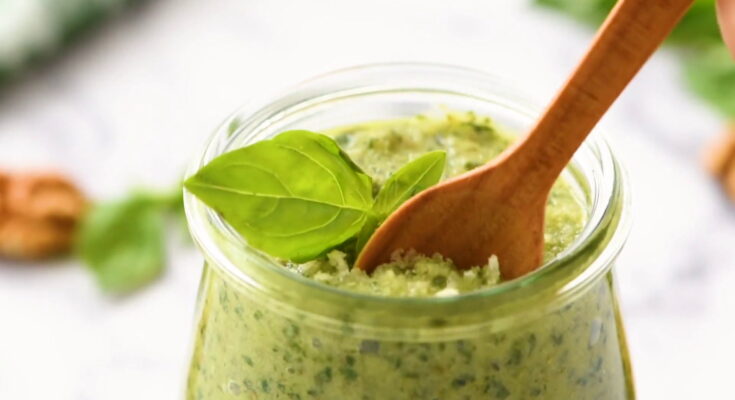Walnut Pesto Recipe: Let’s be real—pesto is one of those magical sauces that can turn the simplest dish into a restaurant-quality meal. Traditionally made with pine nuts, fresh basil, garlic, Parmesan cheese, and olive oil, pesto has earned its place in kitchens worldwide. But what if you could achieve that same irresistible flavor while giving your wallet a break and your taste buds something new? That’s where walnut pesto comes in.
Walnut pesto is rich, creamy, slightly earthy, and completely satisfying. Swapping pine nuts with walnuts adds a new dimension of flavor—more robust, nutty, and buttery. It’s a game-changer if you’re looking to shake things up in your pesto routine. Plus, walnuts are cheaper and easier to find, making this version both budget-friendly and gourmet at the same time.
What makes walnut pesto shine is not just the ingredient switch. It’s how all the flavors come together. Imagine a silky blend of toasted walnuts, fresh basil, sharp Parmesan, and smooth olive oil—all with a hint of garlic to pull it together. You’ve got yourself a sauce that works with pasta, sandwiches, grilled veggies, and even as a dip.
So, if you’re ready to step up your sauce game, roll up those sleeves. We’re diving into this easy, foolproof step-by-step guide to making the perfect walnut pesto from scratch.
Ingredients You’ll Need
You can’t make a killer walnut pesto without high-quality ingredients. The fresher, the better. Here’s what you’ll need:
Fresh and Flavorful Essentials:
- Walnuts – 1 cup (lightly toasted for deeper flavor)
- Fresh basil leaves – 2 cups (packed)
- Garlic cloves – 2 to 3 (depending on how garlicky you like it)
- Parmesan cheese – ½ cup (freshly grated)
- Olive oil – ½ to ⅔ cup (extra virgin recommended)
- Salt and pepper – to taste
- Lemon juice – 1 tablespoon (optional, but adds brightness)
Optional Add-Ins for a Flavor Twist:
- Spinach or arugula – for extra greens and a peppery flavor
- Red pepper flakes – for a touch of heat
- Nutritional yeast – to make it vegan without losing the cheesy flavor
Keep in mind, pesto is very forgiving. You can tweak the measurements and add or subtract ingredients to match your taste or dietary needs. The main players—walnuts, basil, garlic, cheese, and oil—form the backbone, but everything else is customizable.
Tools and Equipment Required
Making walnut pesto doesn’t require a professional kitchen setup. Just a few basic tools and you’re good to go:
- Food processor or high-speed blender – The easiest way to blend everything to the right consistency.
- Spatula – To scrape down the sides during blending.
- Measuring cups and spoons – For accuracy, especially if it’s your first time.
- Small skillet or oven – To toast the walnuts (optional but recommended).
- Airtight jars or containers – For storing the pesto.
Now that you’ve got your ingredients and tools ready, let’s move on to the heart of it—the step-by-step process to creating this delicious walnut pesto.
Step-by-Step Walnut Pesto Recipe
Step 1: Gather All Ingredients
Before you begin blending away, make sure all your ingredients are prepped and ready. This makes the process smooth and ensures nothing gets forgotten mid-recipe. Wash and dry your basil leaves thoroughly—they need to be completely dry to avoid a watery pesto. Grate your Parmesan fresh if possible for maximum flavor. Peel your garlic and set everything out so you can move quickly from one step to the next.
Step 2: Toast the Walnuts
Toasting the walnuts is optional, but highly recommended. It intensifies their flavor and removes any bitterness. Just toss the walnuts in a dry skillet over medium heat for about 5-7 minutes, stirring frequently, until they start to smell nutty and turn golden brown. Let them cool slightly before adding them to the food processor.
Toasting tip: You can also toast them in an oven at 350°F (175°C) for 8-10 minutes—just don’t walk away. Walnuts can go from perfect to burnt in seconds.
Step 3: Blend the Base Ingredients
In your food processor or blender, combine the cooled walnuts, basil, garlic, and Parmesan. Pulse a few times until everything is chopped up but not fully blended. This step ensures that the ingredients are evenly distributed before you add the olive oil.
Step 4: Add Olive Oil Gradually
With the processor running, slowly drizzle in the olive oil until the pesto reaches your desired consistency. Some like it thicker and chunky; others prefer it silky smooth. You can stop the machine, scrape down the sides with a spatula, and taste as you go.
Optional: Add a splash of lemon juice at this point for some added brightness. It’s especially helpful if your basil is on the bitter side or if you want a slightly tangy finish.
Step 5: Adjust Seasoning to Taste
Once everything is well blended, give your pesto a taste. Add salt and pepper as needed. Remember, Parmesan already adds saltiness, so go easy and taste after each pinch. If the flavor needs more kick, add another garlic clove or a pinch of red pepper flakes.
Once you’re happy with the taste and texture, your walnut pesto is ready to go!
How to Store Walnut Pesto
Once you’ve created your delicious walnut pesto, you’ll want to store it properly to keep that flavor fresh and vibrant for as long as possible. This sauce may be rustic and simple, but a little care in storage goes a long way.
Best Storage Practices
Transfer your freshly made pesto into a clean, airtight container. A small mason jar or glass container with a tight-fitting lid works best. To help prevent browning and oxidation (which can dull the flavor and appearance), drizzle a thin layer of olive oil over the top of the pesto before sealing it. This creates a natural barrier from the air and helps preserve the beautiful green color.
Store it in the refrigerator, where it will keep well for about 5 to 7 days. Always use a clean spoon each time you scoop some out. Introducing dirty utensils can shorten the shelf life due to bacteria.
Can You Freeze Walnut Pesto?
Absolutely. Freezing is a great way to extend the life of your walnut pesto, especially if you made a big batch or want to meal-prep ahead. Portion the pesto into ice cube trays or small silicone molds for individual servings. Once frozen solid, pop them out and transfer to a freezer-safe bag or container.
These frozen cubes are perfect for tossing into hot pasta, soups, or rice dishes. When stored properly, frozen walnut pesto can last up to 6 months in the freezer without losing much flavor or texture.
Just remember: avoid heating pesto directly on high heat. Doing so can dull the flavor and turn the basil bitter. Instead, stir it into warm dishes at the end of cooking.
Serving Suggestions
You’ve made your walnut pesto, stored it like a pro—now what? Time to enjoy it! This sauce is incredibly versatile. It can go beyond pasta and become your go-to flavor bomb for dozens of meals.
Pasta Dishes That Shine
This one’s obvious, but it’s worth emphasizing. Toss your pesto with hot, freshly cooked pasta—anything from spaghetti to fusilli to penne. Add a splash of reserved pasta water to help the pesto cling to the noodles and form a creamy, luscious coating.
Want to take it up a notch? Throw in some roasted cherry tomatoes, grilled chicken, sautéed mushrooms, or a handful of baby spinach. Pesto pasta bowls can be as simple or gourmet as you like.
Other Creative Ways to Use It
- Spread it on toast or sandwiches – Use it like a tapenade or mayo replacement. It’s especially amazing on turkey or veggie sandwiches.
- Top grilled meats or fish – Walnut pesto adds a rich, herbal punch that pairs beautifully with grilled chicken, salmon, or even steak.
- Mix into soups or stews – Stir a spoonful into a bowl of vegetable soup or lentil stew to add depth.
- Use it as a dip – Serve it with crackers, pita chips, or raw veggies for a quick appetizer.
- Drizzle over roasted vegetables – It transforms even the simplest roasted potatoes, carrots, or cauliflower.
Bottom line: if you’re looking at your meal and thinking, “This could use a little something extra,” walnut pesto is probably the answer.
Nutritional Benefits of Walnuts
One of the biggest perks of using walnuts in pesto? The health benefits. These little nuts are loaded with nutrients that do your body good—so this pesto isn’t just tasty, it’s good for you too.
Brain Boosting Goodness
Walnuts are often hailed as brain food, and for good reason. They’re rich in omega-3 fatty acids, particularly ALA (alpha-linolenic acid), which supports brain health, reduces inflammation, and may even help improve mood and memory. So next time you’re spooning walnut pesto onto your sandwich, just think—you’re feeding your brain.
Healthy Fats and Antioxidants
Beyond brain benefits, walnuts are a great source of heart-healthy fats. They contain polyunsaturated fats that help lower LDL (bad cholesterol) levels. They’re also packed with antioxidants, including vitamin E and polyphenols, which fight oxidative stress and support overall cellular health.
And don’t forget—they’re also a good source of protein, fiber, magnesium, and B vitamins. So unlike some other rich sauces, this one delivers a nutritional punch alongside its amazing flavor.
FAQs about Walnut Pesto Recipe
1. Can I use different nuts in this pesto?
Yes! Walnuts are amazing, but you can substitute almonds, cashews, pecans, or even sunflower seeds. Each will bring a unique twist to the flavor.
2. How long does walnut pesto last in the fridge?
Stored in an airtight container with a layer of olive oil on top, it will stay fresh for 5 to 7 days in the refrigerator.
3. Is walnut pesto vegan?
It can be! Just skip the Parmesan cheese or use a vegan alternative like nutritional yeast to keep that cheesy flavor without dairy.
4. Can I make walnut pesto without a food processor?
Yes, but it’s more work. Use a mortar and pestle for a traditional touch, or finely chop everything and mix it by hand.
5. What herbs can I substitute for basil?
Try arugula, parsley, cilantro, or even spinach if you’re out of basil. Just note that each brings a different flavor profile.
Conclusion
And there you have it—a full breakdown of how to make, store, and enjoy the perfect walnut pesto. From its bold, nutty flavor to its versatility in dishes and its impressive health benefits, this sauce is one you’ll want to keep in rotation all year long.
Whether you’re slathering it on pasta, dipping your veggies, or using it as a sandwich spread, walnut pesto is the kind of condiment that makes meals memorable. So next time you’ve got a bundle of basil and a bag of walnuts lying around, don’t just let them sit there—blend them into something amazing.



